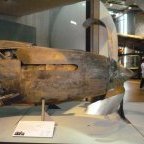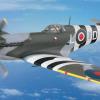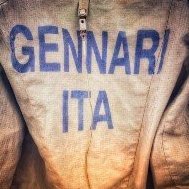Search the Community
Showing results for tags 'Royal Air Force'.
-
This is a double build useing two different kits for a conversion set to produce a variant of the Hawker Tempest that was planned but never came about due to the power plant, The Rolls-Royce R.46 which eventually became the Eagle, fifteen of which powered the Westland Wyvern. The P.1027 as the planned aircraft was known, was dropped in favour of the P.1030 with both projects cancelled later in favour of projects powered by jet engines. So here is a picture of the kits and the conversions Sorry for the glare but they do have to make the box's shiney. Gondor
- 6 replies
-
- 5
-

-
- Project Cancelled
- Propellor
-
(and 1 more)
Tagged with:
-
One of the things that got me back into scale modelling after some years of not building anything was the anime Strike Witches. In fact, I liked the anime so much that I set on a mission to find, buy, and build the aircraft the real pilots used (from which the Strike Witches girls were based from). The story so far: In the year 1939, an alien race know as the Neuroi invaded Europe, conquering the contienent in a matter on months. The only mass of land these invaders weren't able to conquer was Britannia, protected from the land Neuroi by the Britannian channel. Fast forward to 1944, the 501st Joint Fighter Wing, an elite squadron formed by the top aces of different air forces of the world, began fighting back the Neuroi with their Striker Units, aircraft-like machines which are attached to their legs and allow the girls to take the fight back to the Neuroi. The pilots of the 501st JFW are Mina Dietlinde Wilcke, Mio Sakamoto, Gertrud Barkhorn, Erica Hartmann, Francesca Lucchini, Charlotte E. Yeager, Lynette Bishop, Yoshika Miyafuji, Eila Imatar Juutilainen, Sanya V. Litvyak and Shizuka Hattori. I have built all the aircraft from the real pilots, however, the only one which didn't have a real ace was Lynette Bishop. She uses an Ultramarine Spitfire Mk.IX and, in the second season, a Spitfire Mk.22. I've already built the Spitfire 22, so I thought on building the Mk.IX, used by Lynette in the first season. The chose kit is the Revell/Hasegawa Supermarine Spitfire Mk.IX/XVI in 1:48. I decided to start the kit by building the most tedious part of any WW2 propeller plane, the propeller. I painted the blades in matt black and the nose cone in Sky. I then masked the upper part of the nose cone and painted the lower half of it in red. Cockpit: Fuselage halves and cockpit: Cockpit glued to the fuselage: Wings. Options are provided for extended or clipped wingtips for either the Mk.IX or XVI. The same goes for the rudder. And here's where I'm now. Painting will start as soon as I come back home.
-
Hi everyone This is my 1/72 Merlin HC.3 by Italeri. This was a beautifully detailed kit of a beautiful aircraft. The panel line where nice and it had realistic raised rivets covering most of the model apart from the underside. It had a Very nice fit and required barely any filler. The inside was lacking detail, so I created the texture on the walls out of an old metal takeaway container. I created the texture by running the back of the hobby knife to create small lines. I painted it in RC027 Forest green. The decals conformed well to details and where nice and thin. I decided to buy AK panel liner and odourless thinner to try weathering with oil paints. This attempt went better than last time when my thinner removed the pain. I then sealed it in a matt varnish. Thanks for looking
- 12 replies
-
- 32
-

-
- Royal Air Force
- Merlin HC3
-
(and 1 more)
Tagged with:
-
Airfix 1/48 Supermarine Spitfire Mk.Vb "Build Introduction" (4.1.16) Hello Chaps, In 3 weeks time, my wife and I will be moving to our new home, so, I'm not going to start another large scale plane build until we are settled in. But, that said, I feel I might be able to grab a few hours here and there, in between packing, to build a smaller quicker build kit. Therefore, I've chosen this kit, which was one of five kits that my wife bought me for Christmas from the Airfix "Black Friday" sale. I have made a start on her this week, but haven't found the time to start a WIP on here until now. So, without further ado, here goes..... The box is a typical Airfix two-piece construction- Lid and Base, which I much prefer compared to the end opening single units offered by Revell. The box art on the lid shows a Mk.Vb chasing and shooting down an enemy aircraft over the Mediterranean waters and is shown in the first of two color scheme/markings that are offered with this kit. The color scheme and markings are for the aircraft flown by Pilot Officer Robert Wendell "Buck" McNair D.F.C (Royal Canadian Air Force), No.249 (Gold Coast) Squadron, Royal Air Force, Operation "Spotter", Ta'Qali (Ta Kali), Malta, March 1942. This is the version that I will be modeling. On the sides of the box there are 5 CAD generated images showing some of the details included with this kit and the two options of color scheme and marking... Inside the box there is a large clear polythene bag containing 5 grey sprues and a smaller clear bag containing a single clear sprue. There is a 16 page Assembly/Instruction booklet and one sheet of decals... The decals are typical AIrfix, which I personally think are some of the best decals on the market, they are nicely printed, with roundels in register, minimal carrier film and the decals are nice and thin and have a matt/satin finish.... The 16 page booklet is printed in black, white, red and yellow and the last two pages showing the painting and decal instructions offering two options of color schemes and markings, are in full color. There are 46 assembly stages which are very clear with CAD generated images, clearly marked part numbers and color call outs. All colors are for Humbrol paints only will require converting should you choose other brand paints. The five grey sprues are very well molded, with nice crisp clean parts that have zero to minimal flash, if any. There is no warp, distortion, stress marks and sink to be seen and ejector pin witness marks are only visible on the inside of some parts. Other parts are ejected via "ejector slugs" that exist outside of the part geometry which eliminates any ejector pin witness marks on the parts. Sprue "A" Sprue "B" Sprue "C" Sprue "D" Sprue "E" Clear Sprue "F" includes options for open or closed canopies with three styles of hood available. All parts are nicely molded and very clear. Well, that's it for the introduction, so I'll see you guys when I have a "Build Update" ready to report. In the meantime, if you'd like to watch my YouTube Channel "Build Introduction" video for this kit, then here is the link to that: Thanks in advance for taking a look at this WIP, watching the video and leaving any comments, should you do so, much appreciated! Happy modeling and have fun! Cheers, Martin
- 16 replies
-
- 3
-

-
- Airfix
- 1-48 Scale
- (and 8 more)
-
Hasegawa kit with Zoom photo-etched parts from Eduard, decals from Eagle Strike Range; except of them, i built my Sabre straight OOB and i had lot of fun. Paint with Gunze's acrylic H330, H331 and H56 for the blu (i know it's not the right PRU blu, but for me looks right!). Hope you like it And now... a couple of Sabres! thanks for looking ciao Ale
- 18 replies
-
- 11
-




-01_compress20.thumb.jpg.876237f478e7de3cb420ca2f41976d87.jpg)

